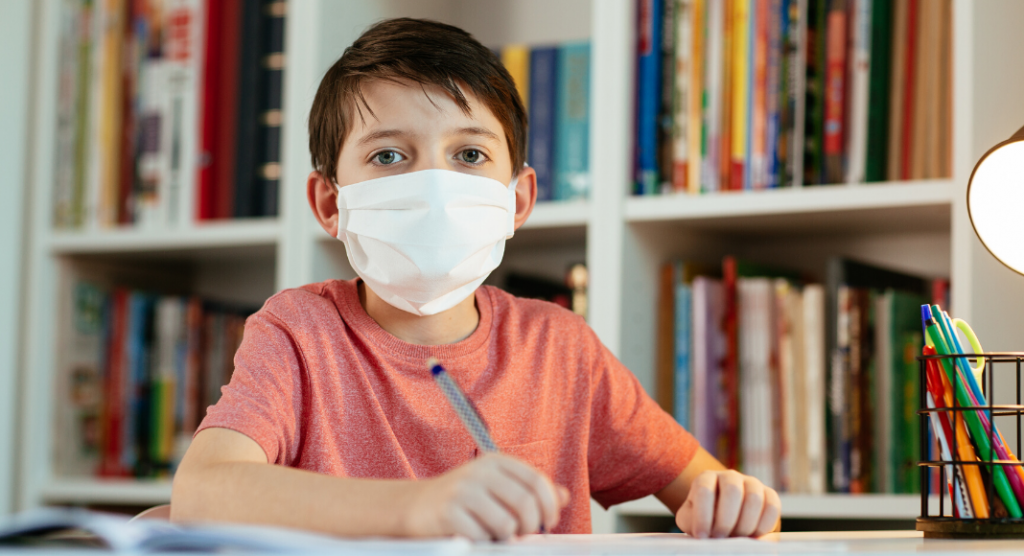The TEA based their guidelines on the CDC’s research on how COVID-19 affects young children as well as adults. They also took into consideration the American
Academy of Pediatrics recommendations that balance risk versus the need for children to be physically present in school.
WARNING :: Each school district will take this information and base their own district safety protocols from these guidelines. Look for additional information coming soon from your local school district, but for now, this is a start!
The TEA Public Health Planning Guidance contains a LOT of information, but here’s what we believe you as parents should know.
WHAT PARENTS SHOULD KNOW FROM THE TEA GUIDELINES
Campuses are required to notify parents at a minimum of ONE WEEK prior to the start of school their comprehensive plan for returning to campuses. They must take the following into consideration:
1) As always, students MUST attend 90% of the days a course is offered (with some exceptions) in order to be awarded credit for the course and/or to be promoted to the next grade.
2) Student attendance may be earned through the delivery of virtual instruction AND any parent may request that their student be offered virtual instruction from any school system that offers such instruction.
3) If a parent who chooses virtual instruction and then wants their child to switch to an on-campus instructional setting, they can do so, but school systems are permitted to limit these transitions to occur only at the end of a grading period, if it will be beneficial to the student’s instructional quality.
- If a parent requests virtual instruction and the school does not offer it, the parent may enroll in another school that does offer it for transfer students.
4) During the first three weeks of school, to facilitate an effective back-to-school transition
process, school systems may temporarily limit access to on-campus instruction.
:: TEMPERATURE CHECKS ::
1) School systems must require teachers and staff to self-screen for COVID-19 symptoms before coming onto campus each day. School systems may consider screening students for COVID-19 as well.
2) Parents must ensure they do not send a child to school on campus if the child has COVID-19 symptoms OR is lab-confirmed with COVID-19.
- Regularly performing a forehead temperature check of otherwise asymptomatic students in school is not recommended, but the practice is also not prohibited by this guidance.
- Parents may also opt to have their students receive remote instruction if their child has had close contact with an individual who is lab-confirmed with COVID-19 until the 14-day incubation period has passed.
:: IF A STUDENT HAS SYMPTOMS OR IS DIAGNOSED ::
1) Schools must immediately separate any student who shows COVID-19 symptoms while at school until the student can be picked up by a parent or guardian.
2) Schools should clean the areas used by the individual who shows COVID-19 symptoms while at school (student, teacher, or staff) as soon as is feasible.
3) Schools must notify all teachers, staff, and families of all students in a school if a lab-confirmed COVID-19 case is identified among students, teachers or staff who participate on any on-campus activities.
4) Any individuals who themselves either are lab-confirmed to have COVID-19; or experience the symptoms of COVID-19 must stay at home throughout the infection period, and cannot return to campus until:
- at least three days (72 hours) have passed since recovery (resolution of fever
without the use of fever-reducing medications), AND
- the individual has improvement in symptoms (e.g., cough, shortness of
breath), AND
- at least ten days have passed since symptoms first appeared.
:: CLEANING & SANITIZING ::
1) Schools should attempt to have hand sanitizer and/or handwashing stations with soap and water at each entrance.
2) They should also attempt to provide hand sanitizer and/or handwashing stations with soap and water in every classroom.
3) Students, teachers, staff, and campus visitors should be encouraged to sanitize and/or wash hands frequently.
4) Campuses should institute more frequent cleaning practices, including additional cleaning by janitorial staff, as well as provide the opportunity for children to clean their own spaces before and after they are used, in ways that are safe and developmentally appropriate.
:: CLASSROOMS & HALLWAYS ::
1) Whenever possible, schools should open windows or otherwise work to improve airflow by allowing outside air to circulate in the building.
2) Schools are required to comply with the governor’s executive order regarding the wearing of MASKS (whatever the executive order is at the time).
- Masks include non-medical grade disposable face masks, cloth face coverings (over the nose and mouth), or full-face shields to protect eyes, nose, and mouth.
- It may be impractical for students to wear masks or face shields while participating in some non-UIL athletic or other extracurricular activities.
- When it is impractical for students to wear masks or face shields during those activities, schools must require students, teachers, staff, and visitors to wear masks or face shields when entering and exiting facilities and practice areas and when not actively engaging in those activities.
3) Schools may, for example, allow students who are actively exercising to remove masks or face shields, as long as they maintain at least six feet of distance from other students, teachers, and staff who are not wearing masks or face shields. However, schools must require students, teachers, and staff to wear masks or face shields as they arrange themselves in positions that will allow them to maintain safe distancing.
4) In classroom spaces that allow it, consider placing student desks a minimum of six feet apart when possible.
5) In classrooms where students are regularly within six feet of one another, schools should plan for more frequent hand washing and/or hand sanitizing and should consider whether increased airflow from the outdoors is possible.
6) When feasible and appropriate (for example, in physical education classes as weather permits), it is preferable for students to gather outside, rather than inside, because of likely reduced risk of virus spread outdoors.
7) Consider adding dividers between bathroom sinks, especially when students cannot be at least six feet apart while using the sinks.
:: SCHOOL HOURS ::
Schools should consider:
- staggering school start and end times
- assigning students to entries to ensure even distribution of students entering/exiting at each door
- providing guidance to students to enter one at a time and wait six feet apart outside the entrance
- where appropriate, encouraging parents to remain outside during drop-off and pick-up
:: LUNCHES ::
1) School systems should consider practices that reduce the likelihood that students meet the close contact definition (defined below) at lunch.
- This could include having students eat lunch at their desks.
- It could include the use of seats that are spaced at least 6 feet apart.
- It could include the use of dividers on cafeteria tables if they can serve the purpose of shielding the students from respiratory droplets with which they might otherwise come into contact.
2) For meal service itself, consider individually plated meals with disposable food service items for students who do not bring their own lunch.
:: BUSES & TRANSPORTATION ::
1) School systems should consider requiring students and staff to use hand sanitizer upon boarding the bus.
2) When possible, schools should open windows to allow outside air to circulate in the bus.
3) School systems should encourage families to drop students off, carpool, or walk with their students to school to reduce possible virus exposure on buses.
4) Buses should be thoroughly cleaned after each bus trip, focusing on high-touch surfaces such as bus seats, steering wheels, knobs, and door handles.
:: VISITORS ::
1) Parents and other adults can visit schools, as permitted by local school system policies. During these visits, parents and other visitors must follow virus prevention and mitigation requirements of the school.
2) School systems should restrict visits in schools to only those essential to school operations.
3) Before visitors are allowed onto campuses, school systems must screen all visitors.














